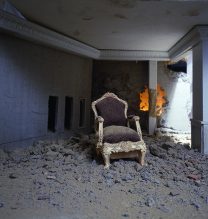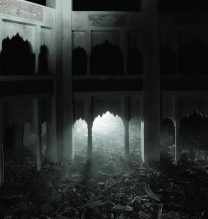Ashes
Wafaa Bilal
Ashes Series
Philosophy
The Ashes Series investigates the impact of the destruction of private, domestic spaces
in war and the images of such destruction. These intimate spaces are literally ripped
open and become public through external violence and the act of destruction. I want to
make these spaces intimate again, to re-domesticate them and to bring the viewer closer
to them, and thus closer to the destroyed culture. The destruction of the living space by
imperial power serves to strip indigenous people of dignity and to impose the occupier
culture on the occupied. By turning the private into an image for the public to see, I hope
these images will enter human consciousness and function as a symbolic reminder of
the engine of oppression in human and cultural conflict.
The origins of the images may appear to be ambiguous at first, but upon looking more
closely, it becomes clear that the images reference media photographs of the conflict in
Iraq to anyone familiar with such photographs. The images thus have a dual meaning:
those unfamiliar with the referenced photographs will look upon the images mainly
through an aesthetic or emotional lens, and for those who recognize the sources, the
images will be politically charged. This duality serves to spark a dialogue between
aesthetics and politics without overwhelming the viewer.
Western culture rejects images of violence and war in order not to be implicated in the
resultant suffering, as the act of seeing such images and knowing of their existence
creates passive participation and acceptance of such conditions. Consequently horror is
aestheticized or censored and incorporated into the “comfort zone” of acceptable media
images. Once images of violence are made acceptable or unreal, dehumanization of the
suffering may occur. Dehumanization of conflict is useful to those who benefit from the
conflict to achieve their own objectives, such as government and corporate interests, as
it allows for inaction by the populace and for the destruction to continue. There is a
dialectic between the government and corporate interests who commit acts of violence
and the larger society, which may choose not to act until it sees whether the outcome will
benefit it or not, whether it will enhance its comfort or not. However, if the culture fully
faces and accepts images of real violence, humanization of the conflict will occur,
leading to empathy and the ability to relate to the conflict and those suffering, and
eventually to action to stop the destruction.
Images of war in the media are a collaboration between two cultures, on the one side the
occupied or destroyed, and on the other the occupier or destroyer. My reconstructions
of these images represent both the desire for peace and the fear of the destruction of
culture and society, with the replacement of that society with a more radical and violent
one. The recreation and beautification of these images of horrific moments is an attempt
to free them from restriction in order for them to become a part of our visual history.
To reconstruct the media images, I build miniature models based on photographs of
destruction in Iraq. The models function as transitional spaces, echoing the original
media images while also becoming ephemeral. However, unlike the media photographs
and reality, my images are absent of human figures. Unoccupied of any atrocities, they
remain pure, with the presence of the human spirit represented only by 21 grams of
human ashes mixed with other ashes and spread over the model landscape, literally
bringing a human aura to the images. The resultant monochromatic whiteness of the
space indicates the removal of human presence and violence from the aftermath of
horrific events while rendering every object equal in importance. White also remains a
symbol of peace, hope, and the ability to heal and start anew.
I construct the miniature models using such materials as cardboard, wood panels,
styrofoam, plaster, concrete, paint, and a mix or organic ashes and miniature objects. I
considered reconstructing the media images using 3D computer modeling but ended by
disregarding this method of working due to the lack of physical presence. Building the
models, on the other hand, allows me to be involved physically with the material over a
period of time, allowing the time to become a meditational healing process and spiritual
journey. The photographs of these models are printed large in order to impact the
viewer physically, as the body reacts instinctually to the size of image it is confronted
with.
The models serve as mirrors of my desire to return home or to find my home when this is
not possible, and in a sense to rebuild the places where my brother and father were
killed. Reconstructing the destructed spaces is a way to exist in them, to share them
with an audience, and to provide a layer of distance, as the original photographs are too
violent and run the risk of alienating the viewer. It represents an attempt to make sense
of the destruction and to preserve the moment of serenity after the dust has settled, to
give the ephemeral moment extended life in a mix of beauty and violence


